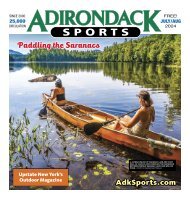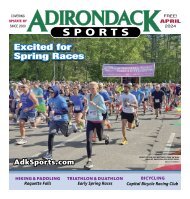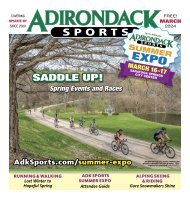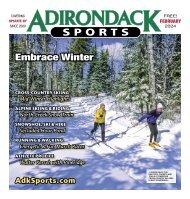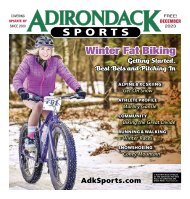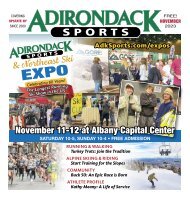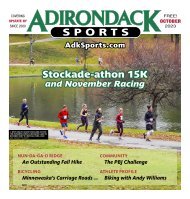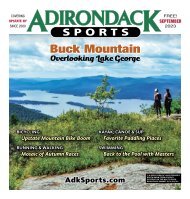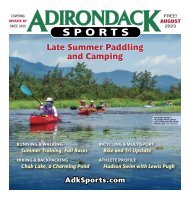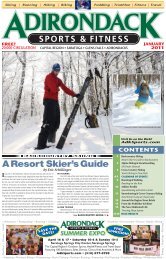Adirondack Sports November 2020
IN THIS ISSUE: 1 – Mountain Biking: Saratoga Shredders Girls Mountain Bike Club 3 – Running & Walking: Thanksgiving Reimagined 5 – News Briefs &From the Publisher 7 – Hiking & Snowshoeing: The Secret Views of Eleventh Mountain 9 – Athlete Profile: Skiing with Jack & Cathy Hay 12-14 – CALENDAR OF EVENTS: Find Races, Events & Things to Do! 15 – Hiking, XC Skiing & Snowshoeing: Prepare for Late Fall Adventures 16 – Alpine Skiing: Willard, The Little Mountain That Could 17 – Bicycling: Winter Riding Options 19 – Run, Walk & Snowshoe: Best Bets for Winter Running
IN THIS ISSUE:
1 – Mountain Biking: Saratoga Shredders Girls Mountain Bike Club
3 – Running & Walking: Thanksgiving Reimagined
5 – News Briefs &From the Publisher
7 – Hiking & Snowshoeing: The Secret Views of Eleventh Mountain
9 – Athlete Profile: Skiing with Jack & Cathy Hay
12-14 – CALENDAR OF EVENTS: Find Races, Events & Things to Do!
15 – Hiking, XC Skiing & Snowshoeing: Prepare for Late Fall Adventures
16 – Alpine Skiing: Willard, The Little Mountain That Could
17 – Bicycling: Winter Riding Options
19 – Run, Walk & Snowshoe: Best Bets for Winter Running
You also want an ePaper? Increase the reach of your titles
YUMPU automatically turns print PDFs into web optimized ePapers that Google loves.
HIKING, XC SKIING & SNOWSHOEING<br />
NOVEMBER <strong>2020</strong> 15<br />
Prepare for<br />
Late Fall<br />
Adventures<br />
By Rich Macha<br />
PHOTOS BY RICH MACHA<br />
PICK A NICE WEATHER DAY, PROPERLY<br />
OUTFITTED, AND YOU’LL BE REWARDED.<br />
SPIKES GIVE YOU BETTER TRACTION<br />
AND ARE RECOMMENDED IN<br />
SLIPPERY OR ICY CONDITIONS.<br />
YOU AND YOUR BEST FRIEND<br />
SHOULD WEAR BRIGHT COLORS<br />
DURING HUNTING SEASON.<br />
AN INSULATED<br />
PAD, WHETHER<br />
SHORT OR LONG,<br />
CAN MAKE FOR<br />
A COMFORTABLE<br />
BREAK.<br />
A NOVEMBER PADDLE ON LAKE PLACID.<br />
The fall foliage season has ended and we are<br />
now in the fall “it’s beginning to feel a lot<br />
like winter” season, but there is no reason<br />
we have to curtail our outdoor activities as long as<br />
we prepare ourselves accordingly. Weatherwise,<br />
<strong>November</strong> can be all over the place, with the possibility<br />
of some warm sunny days but some brisk<br />
and breezy days are also highly likely. December<br />
weather, especially in the <strong>Adirondack</strong>s, takes a<br />
big step toward winter. So, whether you plan to<br />
hike, paddle or ski, now is the time to plan and<br />
prepare for the possibilities.<br />
In Albany last year, 45% (27.9”) of the seasonal<br />
snowfall fell in December, most of it at<br />
the beginning of the month. Whereas, in the<br />
central <strong>Adirondack</strong>s, Indian Lake received<br />
close to average snowfalls, with 22” in December, 30” in<br />
January, and 29” in February. This year, winter has already<br />
fired off some early warning shots with a coating of snow in<br />
late October, which quickly melted in lower elevations, but<br />
hung around at higher elevations.<br />
With over two months to go, there has already been a yearly<br />
record of rescues by NYS DEC Forest Rangers in Regions 5<br />
and 6, which encompass the <strong>Adirondack</strong> Park and surrounding<br />
areas. This corresponds to an increase in the number of<br />
folks participating in outdoor recreation. Most commonly,<br />
the rescues involved injured hikers or lost hikers – many of<br />
these incidents were preventable had the hikers planned and<br />
prepared appropriately. With colder weather, the margin for<br />
error becomes greater and the consequences more dire.<br />
Keep in mind that fall is also hunting season. Northern<br />
Zone (basically, north of Saratoga Springs and NY Route 29)<br />
deer hunting season has begun and lasts through December<br />
6, and Southern Zone season goes from <strong>November</strong> 21 through<br />
December 13. During this time, it is best to wear bright colors,<br />
preferably blaze orange – the same goes for your dog too.<br />
Note also that snowmobiles are not allowed on state land<br />
until these hunting seasons are over.<br />
You should avoid wearing cotton clothing whenever perspiration<br />
or any other kind of water is involved since cotton<br />
has no insulative properties when wet and consequently it<br />
can suck the heat right out of you. Dressing in layers gives you<br />
the ability to minimize sweating and regulate your body heat.<br />
Gaiters keep snow and debris from entering your boots, plus<br />
they keep the legs of your pants from getting wet. I seldom<br />
go out without at least four pairs of gloves and mittens – they<br />
can be mixed and matched to keep my fingers warm and I<br />
will have some backups if a pair gets wet.<br />
There are several items that should be in your pack yearround,<br />
often referred to as the “10 Essentials” – a whistle, map,<br />
compass, water, food/snacks, extra socks and warm clothing,<br />
rain/wind gear, headlamp plus extra batteries, first aid kit,<br />
knife (utility tool or Swiss Army have useful extras), toilet<br />
paper, a zip bag for trash (including used toilet paper), space<br />
blanket, fire-starting kit, and some duct tape for repairs in the<br />
field (I also bring some wire and a couple of hose clamps). A<br />
GPS can be beneficial but you should still bring a paper map<br />
and compass. Cellphones can be helpful in an emergency<br />
but service is spotty in the backcountry and batteries do run<br />
down, so a phone should not be depended upon as a substitute<br />
for poor planning and preparation. Until things change,<br />
bring some hand sanitizer and a mask to wear whenever you<br />
can’t maintain a good distance from others.<br />
A vacuum flask of hot chocolate or tea can be just the ticket<br />
with lunch in cool weather. When you stop for a break, you<br />
will be more comfortable if you throw on some warmer clothing<br />
before you get cold – don’t wait until you are cold before<br />
doing so. Chemical hand and toe warmers are inexpensive<br />
and come in handy to warm up the extremities – most will<br />
last for six or more hours – that’s cheap insurance. Bring an<br />
insulated pad to sit on during breaks.<br />
Newly-fallen leaves or snow can obscure the foot tread on<br />
trails and make the way less obvious – you need to pay more<br />
overall attention en route. The leaves can also be slippery,<br />
especially when wet. Hiking poles are recommended for stability,<br />
plus they will help save your knees in the long term,<br />
especially when going downhill. If temperatures have recently<br />
dropped below freezing, ice could have formed in the trail,<br />
so the use of trail crampons, not quite as aggressive as fullon<br />
ice crampons – and often referred to as microspikes these<br />
days – are highly recommended for those times. Kahtoola<br />
MICROspikes started this trend, Hillsound Trail Crampons<br />
have become favorites of many High Peaks hikers, and Black<br />
Diamond has also come forth with some offerings in this vein.<br />
The better informed you are, the better the experience.<br />
Check guidebooks for route descriptions and what to look out<br />
for before you head out. For the price of a restaurant dinner, a<br />
guidebook, written by someone who has done more research<br />
on the subject than most anyone, provides a great long-term<br />
investment – and still outdoes most everything you can find<br />
online. For the <strong>Adirondack</strong>s, there are two series of guidebooks:<br />
the ‘Discover the <strong>Adirondack</strong>s’ series by Bill Ingersoll<br />
and the series by the <strong>Adirondack</strong> Mountain Club. Both are<br />
great for hiking information, but the Discover books do add<br />
more off-trail and paddling destinations. The NYSDEC website<br />
is the best online resource for what to bring and for the<br />
rules and regulations that pertain to the area you plan to visit.<br />
Backcountry conditions for the <strong>Adirondack</strong>s: dec.ny.gov/<br />
outdoor/7865.html. Backcountry conditions for the Catskills:<br />
dec.ny.gov/outdoor/108207.html. These websites are updated<br />
by Thursday evening on a weekly basis. According to a<br />
recent survey, the alltrails.com website and app have become<br />
the most popular source of info for many <strong>Adirondack</strong> hikers<br />
these days but I find it often has errors and lacks detail, so I<br />
tend to think of it as a supplementary source rather than a<br />
primary source of information.<br />
Check your gear for wear and tear before leaving the<br />
house. Look over your boots to make sure the soles are not<br />
delaminating, check the straps on your snowshoes, and look<br />
over your skis for any weaknesses. You certainly don’t want to<br />
be five miles out and have something break on you.<br />
Late fall can still be attractive to some paddlers but I only<br />
recommend it for those who have advanced self and assisted<br />
rescue skills, a good comprehension of cold water survival,<br />
and to those who wear a dry or wet suit. I have a thinking<br />
process which I call “Three Good Reasons” that I go through<br />
before deciding to paddle: if I can think of three good reasons<br />
not to paddle, then I should do something land-based. For<br />
example, I once went to Cedar River Flow in early December<br />
and started out from Wakely Dam in my solo canoe. When I<br />
got out into the main part of the flow the wind was blowing<br />
fairly hard and was not making things easy. The water was<br />
very cold, I was paddling by myself, and the wind was a problem:<br />
three good reasons not to continue, so I turned around<br />
and went for a hike instead.<br />
It’s not a good thing to spend too much time on your butt<br />
so do your homework, assemble the proper gear and clothing,<br />
and get out and enjoy some fresh air.<br />
A lover of wild places, Rich Macha has led many trips for the<br />
<strong>Adirondack</strong> Mountain Club, and has spent 20 years in the<br />
paddlesport/snowsport business. More of Rich’s adventures<br />
can be found at northeastwild.blogspot.com.




